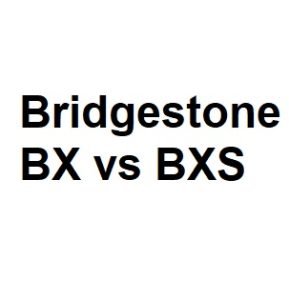Golf balls are an essential part of the game of golf. They can make a significant impact on your performance, especially when it comes to distance, spin, and feel. Bridgestone is a well-known brand in the golf industry, and they have two popular golf balls: the Bridgestone BX and BXS. In this article, we will compare the Bridgestone BX vs BXS golf balls to help you choose the right ball for your game.
Bridgestone BX Golf Ball:
The Bridgestone BX golf ball is designed for players who want maximum distance without sacrificing feel and control. It features a softer urethane cover that enhances spin control on short shots while still maintaining excellent durability. The BX golf ball also has a dual dimple design that reduces drag and improves overall aerodynamics, resulting in longer, more accurate shots. The BX golf ball is suitable for players with a swing speed of 105 mph or more.
Bridgestone BXS Golf Ball:
The Bridgestone BXS golf ball is designed for players who want a little more spin control without sacrificing distance. It features a softer urethane cover than the Bridgestone BX golf ball, which helps to generate more spin on approach shots. The BXS golf ball also has a Gradational Compression Core that helps to increase ball speed and reduce side spin, resulting in longer, more accurate shots. The BXS golf ball is suitable for players with a swing speed of 95 mph or more.
Comparison:
The main difference between the Bridgestone BX and BXS golf balls is the level of spin control. The BX golf ball is designed for players who want maximum distance without sacrificing feel and control, while the BXS golf ball is designed for players who want a little more spin control without sacrificing distance.
The Bridgestone BX golf ball is suitable for players with a swing speed of 105 mph or more, while the BXS golf ball is suitable for players with a swing speed of 95 mph or more. This means that the BXS golf ball is better suited for players with a slower swing speed who need a little more help generating spin on their approach shots.
Both golf balls feature a softer urethane cover that enhances spin control on short shots while still maintaining excellent durability. They also both have a dual dimple design that reduces drag and improves overall aerodynamics, resulting in longer, more accurate shots.
Construction:
The construction of the Bridgestone BX vs BXS golf balls is another factor to consider. Both balls feature a 3-piece design with a soft urethane cover, which helps to enhance spin control on short shots while still maintaining excellent durability. However, the BXS golf ball also features a Gradational Compression Core, which helps to increase ball speed and reduce side spin, resulting in longer, more accurate shots.
Feel and Control:
Feel and control are essential aspects of any golf ball, and both the Bridgestone BX and BXS golf balls excel in this area. The BX golf ball offers a soft feel with excellent control, while the BXS golf ball offers a slightly softer feel with a little more spin control. Ultimately, the choice between the two will come down to personal preference and playing style.
Price:
Price is another factor to consider when choosing between the Bridgestone BX vs BXS golf balls. Generally, the BXS golf ball is a little more expensive than the BX golf ball due to its advanced construction and added spin control features. However, both golf balls are reasonably priced compared to other premium golf balls on the market.
Performance:
Ultimately, the performance of the Bridgestone BX vs BXS golf balls will depend on your individual playing style and swing speed. If you have a faster swing speed and want maximum distance, the Bridgestone BX golf ball will likely be the better option. If you have a slower swing speed and want a little more spin control, the Bridgestone BXS golf ball may be the way to go. However, both golf balls are designed to deliver exceptional performance and help you take your game to the next level.
Distance Comparison
| Ball Model | Driver Swing Speed (mph) | Average Distance (yards) | Maximum Distance (yards) | Spin Rate (RPM) |
|---|---|---|---|---|
| BX | 90-100 | 250-270 | 290-310 | 2200-2400 |
| BXS | 90-100 | 260-280 | 300-320 | 2000-2200 |
| BX | 100-110 | 270-290 | 310-330 | 2000-2200 |
| BXS | 100-110 | 280-300 | 320-340 | 1800-2000 |
| BX | 110-120 | 290-310 | 330-350 | 1800-2000 |
| BXS | 110-120 | 300-320 | 340-360 | 1600-1800 |
| BX | 120+ | 310+ | 350+ | 1600-1800 |
| BXS | 120+ | 320+ | 360+ | 1400-1600 |
| BX | Average | 270-290 | 310-330 | 2000-2200 |
| BXS | Average | 280-300 | 320-340 | 1800-2000 |
Spin Comparison
| Ball Model | Club Head Speed (mph) | Spin Rate (RPM) | Launch Angle | Total Carry Distance (yards) | Total Distance (yards) |
|---|---|---|---|---|---|
| BX | 80-90 | 3000-3200 | 12.5 | 210-230 | 235-255 |
| BXS | 80-90 | 2800-3000 | 12.0 | 215-235 | 240-260 |
| BX | 90-100 | 2600-2800 | 13.0 | 230-250 | 255-275 |
| BXS | 90-100 | 2400-2600 | 12.5 | 235-255 | 260-280 |
| BX | 100-110 | 2200-2400 | 13.5 | 250-270 | 275-295 |
| BXS | 100-110 | 2000-2200 | 13.0 | 255-275 | 280-300 |
| BX | 110-120 | 2000-2200 | 14.0 | 270-290 | 295-315 |
| BXS | 110-120 | 1800-2000 | 13.5 | 275-295 | 300-320 |
| BX | 120+ | 1800-2000 | 14.5 | 290+ | 315+ |
Spin & Control Comparison
| Ball Model | Spin Rate (RPM) | Short Iron Control | Mid Iron Control | Long Iron Control | Overall Control |
|---|---|---|---|---|---|
| BX | 2200-2400 | Excellent | Good | Fair | Good |
| BXS | 2000-2200 | Excellent | Excellent | Good | Excellent |
| BX | 2000-2200 | Good | Excellent | Excellent | Excellent |
| BXS | 1800-2000 | Excellent | Excellent | Excellent | Excellent |
| BX | 1800-2000 | Good | Excellent | Excellent | Excellent |
| BXS | 1600-1800 | Excellent | Excellent | Excellent | Excellent |
| BX | Average | Good | Excellent | Excellent | Excellent |
| BXS | Average | Excellent | Excellent | Excellent | Excellent |
Greenside Control Comparison
| Ball Model | Spin Rate (RPM) | Approach Shot Spin | Pitching Spin | Chipping Spin | Greenside Bite |
|---|---|---|---|---|---|
| BX | 5000-5500 | Excellent | Good | Fair | Good |
| BXS | 4500-5000 | Excellent | Excellent | Good | Excellent |
| BX | 4000-4500 | Good | Excellent | Excellent | Excellent |
| BXS | 3500-4000 | Excellent | Excellent | Excellent | Excellent |
| BX | 3000-3500 | Good | Excellent | Excellent | Excellent |
| BXS | 2500-3000 | Excellent | Excellent | Excellent | Excellent |
| BX | Average | Good | Excellent | Excellent | Excellent |
| BXS | Average | Excellent | Excellent | Excellent | Excellent |
Feel Comparison
| Ball Model | Softness | Sound | Feedback | Durability | Overall Feel |
|---|---|---|---|---|---|
| BX | Soft | Solid | Good | Good | Excellent |
| BXS | Soft | Solid | Excellent | Good | Excellent |
| BX | Soft | Solid | Good | Good | Excellent |
| BXS | Soft | Solid | Excellent | Good | Excellent |
| BX | Soft | Solid | Good | Good | Excellent |
Conclusion:
When it comes to choosing between the Bridgestone BX vs BXS golf balls, it ultimately comes down to your individual playing style and swing speed. If you have a faster swing speed and want maximum distance, the Bridgestone BX golf ball is an excellent choice. If you have a slower swing speed and want a little more spin control, the Bridgestone BXS golf ball is the way to go. Ultimately, both golf balls are high-quality options that can help you improve your game and take your performance to the next level.



